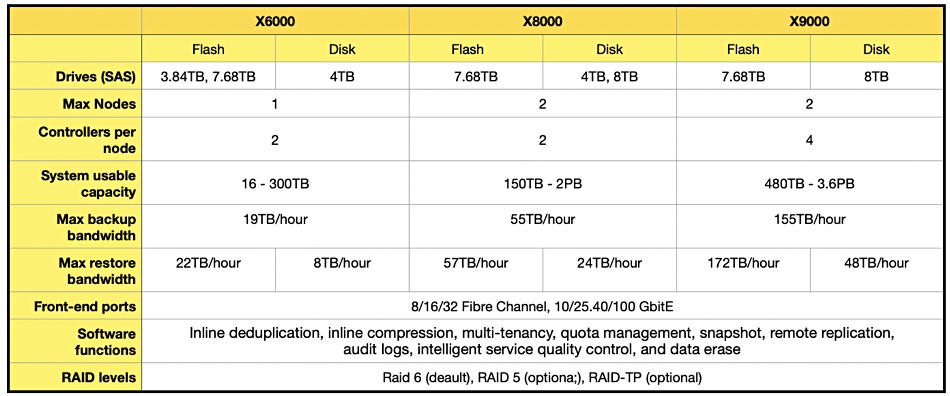Chinese supplier Huawei has an all-flash deduplicating backup target line. How does this OceanProtect range of products compare to the IBM, Pure Storage, and VAST Data all-flash backup target systems?
The OceanProtect range won the Special Prize for Best of Show Award in the Server & Storage category at Interop Tokyo 2022. It has entry-level, mid-range, and high-end products: the X6000, X8000, and X9000. Each comes in an all-flash or disk drive version and the three types differ in capacity and performance as this table illustrates:

We can comment straight away that the disk drive capacities look to be lowish – the three disk drive vendors have been shipping 16 and 18TB drives for some months and 20TB drives are available. The same could be said about the SSDs as 15.6TB drives are available.
The performance numbers are helped by Huawei fitting the product with the CPU-offloading Direct TCP/IP Offload Engine (DTOE) intelligent network interface card. Huawei suggests this doubles array bandwidth compared to ordinary NICs. Huawei says the system puts out a maximum of 480,000 IOPS but doesn’t break that number down by individual product.

The usable capacity is boosted by a multi-layer, inline variable-length deduplication engine, compression and byte-level compaction, with Huawei claiming they provide an extraordinary up to 72:1 data reduction ratio.
The two multi-core controller nodes are in an active:active relationship – failover takes seconds – and system reliability – six nines or 99.9999 percent – is also helped by the optional RAID-TP scheme which can withstand three concurrent drive failures.
Pure’s latest FlashBlade//S has up from seven to ten storage blades, each with one to four flash drives (DFM, Direct Flash Modules). Each DFM has either 24 or 48TB of raw QLC flash capacity, meaning a maximum of 192TB per blade and 1.92PB per system (with ten blades). Pure says this grows to an effective 4PB given 2:1 compression. That exceeds the OceanProtect X9000’s 3.6PB usable capacity.
The prior FlashBlade, which uses TLC flash, can have from seven to 15 blades with 8TB or 52TB capacity in its chassis – a max of 780TB raw, and 1.6PB effective at 2:1 compression.
There can be up to ten FlashBlade//S systems in a cluster with a total capacity of ~20–30PB depending on data compression.
IBM’s FlashArray can be a Veeam backup target. The large 730 has up to 45.5PB of effective capacity, assuming 3:1 compression and a 162TB/hour ingest and restore rate. It has 116TB effective capacity after deduplication and compression. Both numbers surpass the OceanProtect X9000.
VAST Data says its all-QLC flash Universal Storage system can be a backup target and had a maximum capacity of 3.3PB in November 2021. Its latest Ceres chassis, which uses Nvidia BlueField smartNICs, holds up to 1.35PB of raw capacity – 4.05PB at 3:1 data reduction – and 144TB/hour bandwidth; slower than Huawei’s X9000. However, this is a scale-out system so customers just buy more chassis to meet capacity and bandwidth needs.
Bottom line
A full comparison would factor in price against performance for these systems, but that’s where things get complex. At this end of the market, each customer’s requirements are likely to be unique and it’s hard to draw like-for-like comparisons against a pricing sheet. But on a sheer performance and/or capacity basis the IBM, Pure, and VAST systems can exceed the speed and volume of the Huawei OceanProtect systems.








